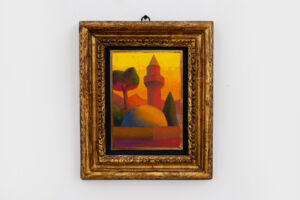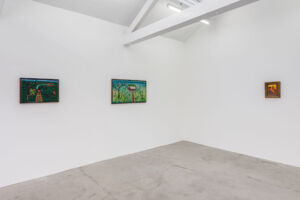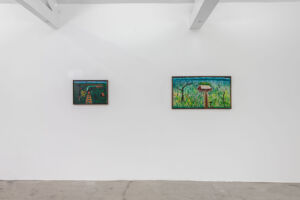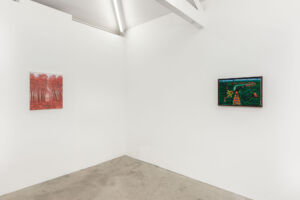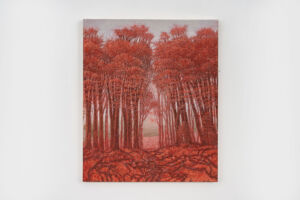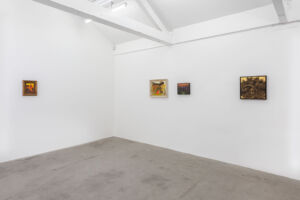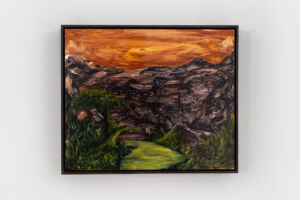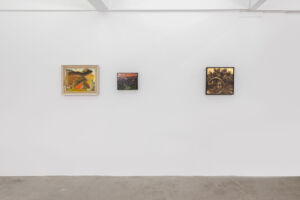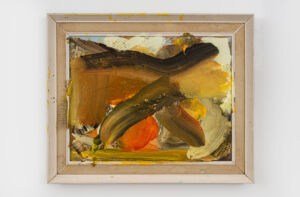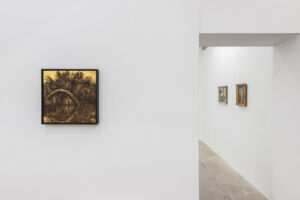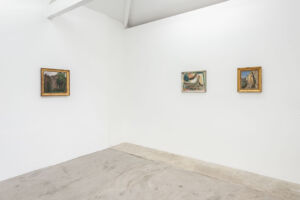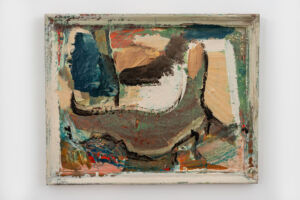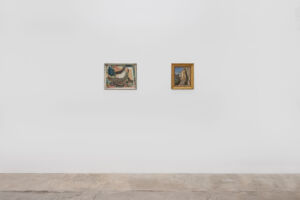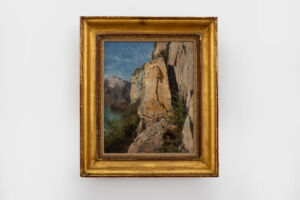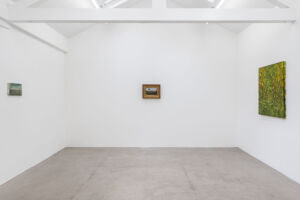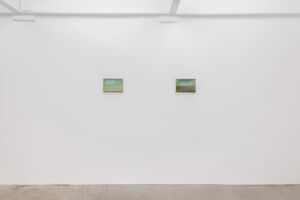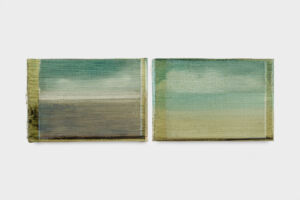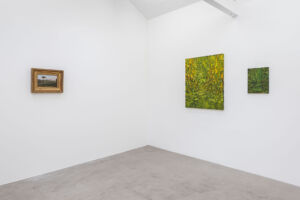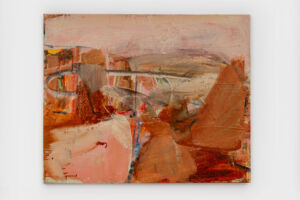‘Cirrus: On Landscape’
Curated by Jenn Ellis
Presented by NISO
Jamiu Agboke, Pierre-Athanase Chauvin, Francesco Cima, Janus La Cour, Katy Moran, Sawako Nasu, SALVO, Ulf Saupe, Alexandre Wagner, José Antonio da Silva
November 14th, 2024 – January 11th, 2025. NISO, 110, New Cavendish St W1W 6XR London UK
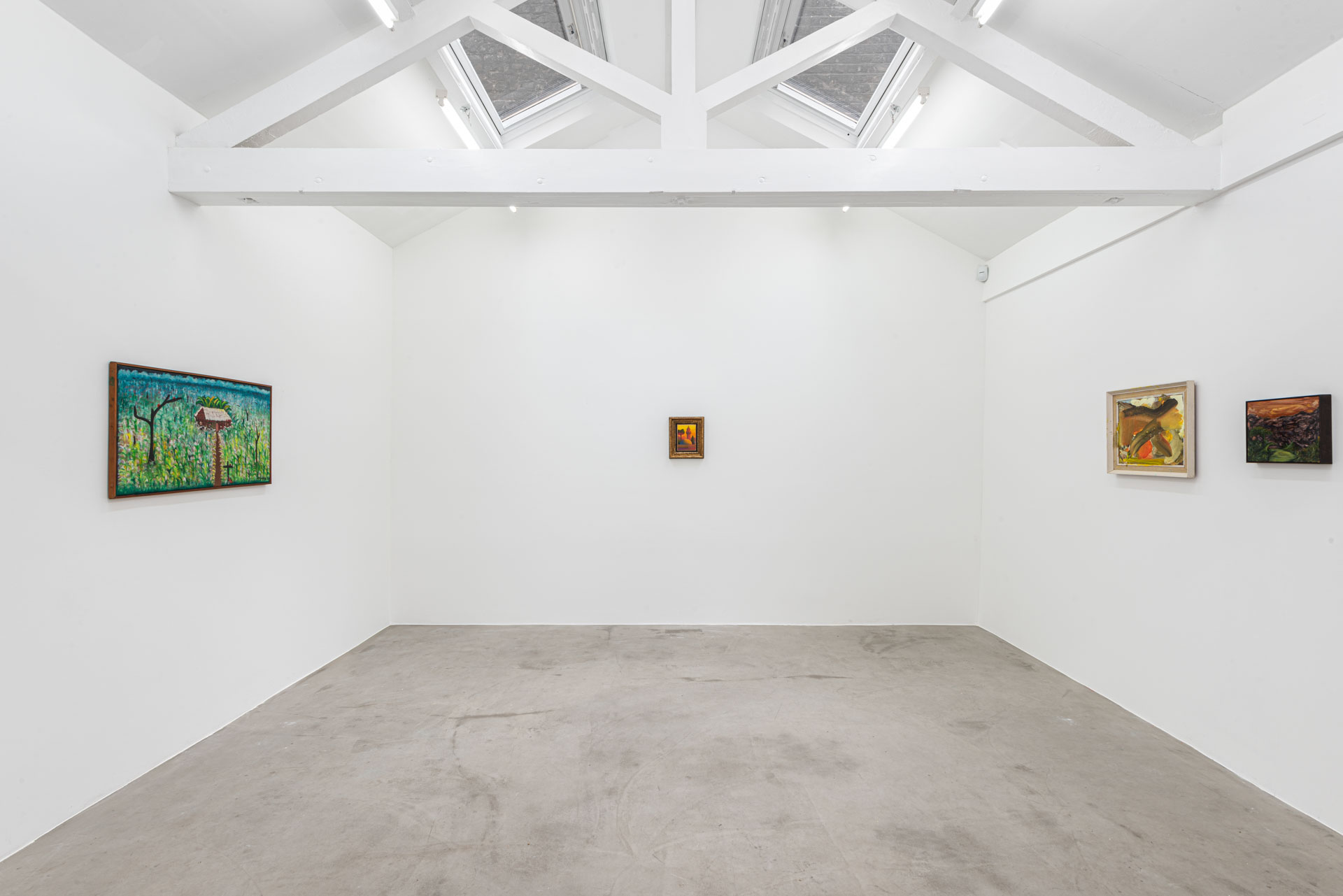
Installation view of Cirrus: On Landscape, November, 2024. NISO, London. Photography: Studio Adamson
Centering on perceptions of the world around us, ‘Cirrus: On Landscape’, at NISO, is a group show placing in dialogue emerging and historical artists, spanning Asia to Europe and Latin America. Taking its cue from a type of cloud – cirrus, a wispy genus that is distinctive for its movement and shifting – the exhibition, curated by Jenn Ellis, points to the evolving nature of our perceptions, whether they be from art historical approaches at different points in time, or distinctive geographic vantage points. Drawing connections between more descriptive or precise articulations over to more emotionally-inclined interpretations, ‘Cirrus: On Landscape’ investigates how the natural environment – as we see or remember it – has inspired artists across centuries and continents. Including works by Jamiu Agboke, Pierre-Athanase Chauvin, Francesco Cima, Janus La Cour, Katy Moran, Sawako Nasu, SALVO, Ulf Saupe, Alexandre Wagner and José Antonio da Silva, the exhibition poses itself as a pan-temporal contemplation of the observed, felt and interpreted world around us.
Opening the exhibition and in the heart of the first room is a work, exhibited publicly for the first time, by SALVO (1947-2015, Italy), whose practice is principally categorised by their richly coloured metaphysical landscapes and cityscapes. ‘Bosnia Erzegovina’ (2006), in its citric hues and modernist articulations of a place, reflects SALVO’s emblematic approach of creating simplified, hyper-saturated compositions that imply abstract concepts like time and memory. Flanked on either side by variations of mnemonic feeling, the triumvirate on the leftmost wall is composed of Francesco Cima (b. 1990, Italy) and Ulf Saupe (b. 1975, Germany). Cima’s work, with its delicate ochre and burgundy hues, depicts with magnanimity and expanse a tall, foliage-filled forest, the roots of each tree trickling through the earth like tributaries. Akin to SALVO, there is a saturation of colour, albeit distinctly more sombre, and there is a comparative sense of pictorial mystery. The landscape is distant, as if a treasured component of his imagination. Saupe shares elements of introspection and a consciousness of journey; his works, which expand on the medium of photography, explore the balance between humanity and nature. Sensitive to process and the incorporation of elements in his pieces themselves, his works encompass mediums from soil and gold leaf, to pigment and pulverised coal.
Extending our considerations of memory and journey-making in the context of an exploration of landscape is a further dialogue, on the rightmost wall, between Katy Moran (b. 1975, UK) and Jamiu Agboke (b. 1989, Nigeria). Moran, in her language of abstraction, conjures atmospheres. Thinking of the landscape from a place of external and internal observation, her paintings are rooted in process and the collection and re-articulation of readymade objects – prior found paintings, frames – which have given way to a new gestural release. Delving into feelings of longing, impression and association, is the work of Agboke. Articulating an observed and recollected terrain, the emphasis turns to one of gesture and movement. Sensorial, the tones of the sky evoke a warmth, a hue that speaks to a geographic and temporal particularity where the sun sets or rises distinctly. As if recollecting a vivid memory, Agboke, like Moran, seem to evoke moments in colour and gesture, in texture and tone, a freedom of wrist being most akin to what’s been perceived and recollected.
On the opposite wall to SALVO are two works by José Antonio da Silva (b. 1909-1996, Brazil), an iconic self-taught artist from Brazil’s rural, labouring classes, who shifted the nation’s relationship and pathway with modern art. Initially working the land as a labourer on coffee, sugar and cotton plantations, da Silva turned to making art at the age of thirty-seven. Distinct to his practice is his contemplation and correlated criticality of the agricultural landscape; exploring on the one hand the riches of the earth, da Silva equally points to its exploitation by industry and how it’s being reshaped forever. ‘Untitled’ (1980), for example, depicts a lush, crop-encircled home; the scene, however, is balanced by the presence of two crosses, rising from the soil, and several leafless trees. Birds are seen circulating in the distance, a seemingly ominous sign. ‘Untitled’ (1984) is even more explicit in its relational critique with modernity: a railroad weaves its way through a forest, a locomotive being at once a sign of the future in progress, while in tandem a tree has been visibly logged on the right. Presenting an important and alternative reflection of memory to the room, da Silva questions the merits of progress, and introduces a consideration of the economic as well as romantic associations with the land that surrounds and makes us.
Entering the second room, we are introduced to more subliminal and pictorial considerations of landscape, exploring the range between observation and expression. In the centre back wall is a masterpiece by Janus Andreas Bartholin la Cour (b. 1837-1909, Denmark), entitled ‘The Ruins of Bramante’s Nymphaeum in Genazzano’ from 1870. Classically trained at the Eckersberg school and the Royal Danish Academy of Fine Arts, la Cour travelled to Italy and Switzerland for inspiration. As the title suggests, the painting is of an archeological site to the southeast of Rome; delicate in its delineation, the stones seem to have been taken over by a hyperbolic overture of vegetation. The skies in the foreground, with their pinkish hues, emblematic of his cloudy yet glowing approaches to the sky. The work is placed in dialogue, on the leftmost wall, with two works by Sawako Nasu (b. 1996, Japan). As if extrapolating a detail from la Cour’s painting, Nasu is inspired, in her paintings, by classical techniques yet strives to balance and contrast these with the contemporary context she creates in. Evoking the unbridgeable distance as well as evolutions between the times of the past and her current present, Nasu’s work evokes landscape as a vision. Aware of being in a constantly shifting art history, her expansive works in their delicacy and attention to the horizon reflect on this element of renewal.
Extending interpretations of the natural world around us is another dialogue, on the opposite wall, between two work by Alexandre Wagner (b. 1986, Brazil) and a historic masterpiece by Pierre-Athanase Chauvin (1774-1832, France). Thinking about the creating and visioning of space, Wagner’s works depict with gesture and rhythm confluences of forests, rivers and cliffs. Furtive, Wagner’s palette is that of earth tones, his strokes ones that combine vigour with lightness. By comparison, Chauvin trained at the Écôle des Beaux Arts in Paris and excelled in a neoclassical style, eventually moving to Rome in 1801-2 where he gained international prominence. Travelling to Naples and Florence in addition to his thence ‘native’ Rome, Italian views became the focus of his perspective; indeed, the work on display is entitled ‘Vue des Pins de la Villa Borghese / prise du derrière la Villa Médicis’, which translates as “view of the pines of the Villa Borghese, taken from behind the Villa Médicis”. Opting for delicate pictorial accuracy, the work gives the impression of having been created ‘en plein air’ or in the open air, rather than back in the studio. The pines additionally lend an element of depth, this feeling of witnessing from afar. From the soft skies to the seeming sways of the trees, however, an element of light movement is permitted to appear.
In the final wall, there is a parting conversation between two works, which explore the extended nuances of the exhibition. On the one hand there is a third work by Katy Moran, which in its gestural releases bridges the themes explored across the two rooms, from memory to rhythm, landscape as something that’s observed but also felt, and the exploration of sensorial elements when it comes to the natural world around us that extends beyond our sight. On the other hand, there is a work by Alexandre Calame (1810-1864, Switzerland) who focused on the natural world with a pictorial leaning on subliminal fascination. Specialised in the Alps, his work varies between an observation of the geological world and a wonder of what it can behold. Capturing moments of natural beauty, Calame’s work encompasses a romantic spirit, depicting grandiose landscapes where nature, untamed by man, preserves its frailty, chisel and rawness.
Ultimately ‘Cirrus: On Landscape’ explores our pluralistic and continuously evolving relationship with the natural landscape. From absolute admiration and observation over to depicting the inevitability of our own involvement – from the archeological sites in Italy over to the laboured erosion in Brazil – the exhibition points to an ever-shifting coexistence between man and nature. From moments of abstraction evoking memory and rhythm in contemporary works, over to details of greater expression as articulated through the skies and foliage in the classical masterpieces, ‘Cirrus: On Landscape’ investigates how things can quickly change, or indeed, are constantly evolving – how the world around us is a matter of our own perception and articulation.
Text by Jenn Ellis
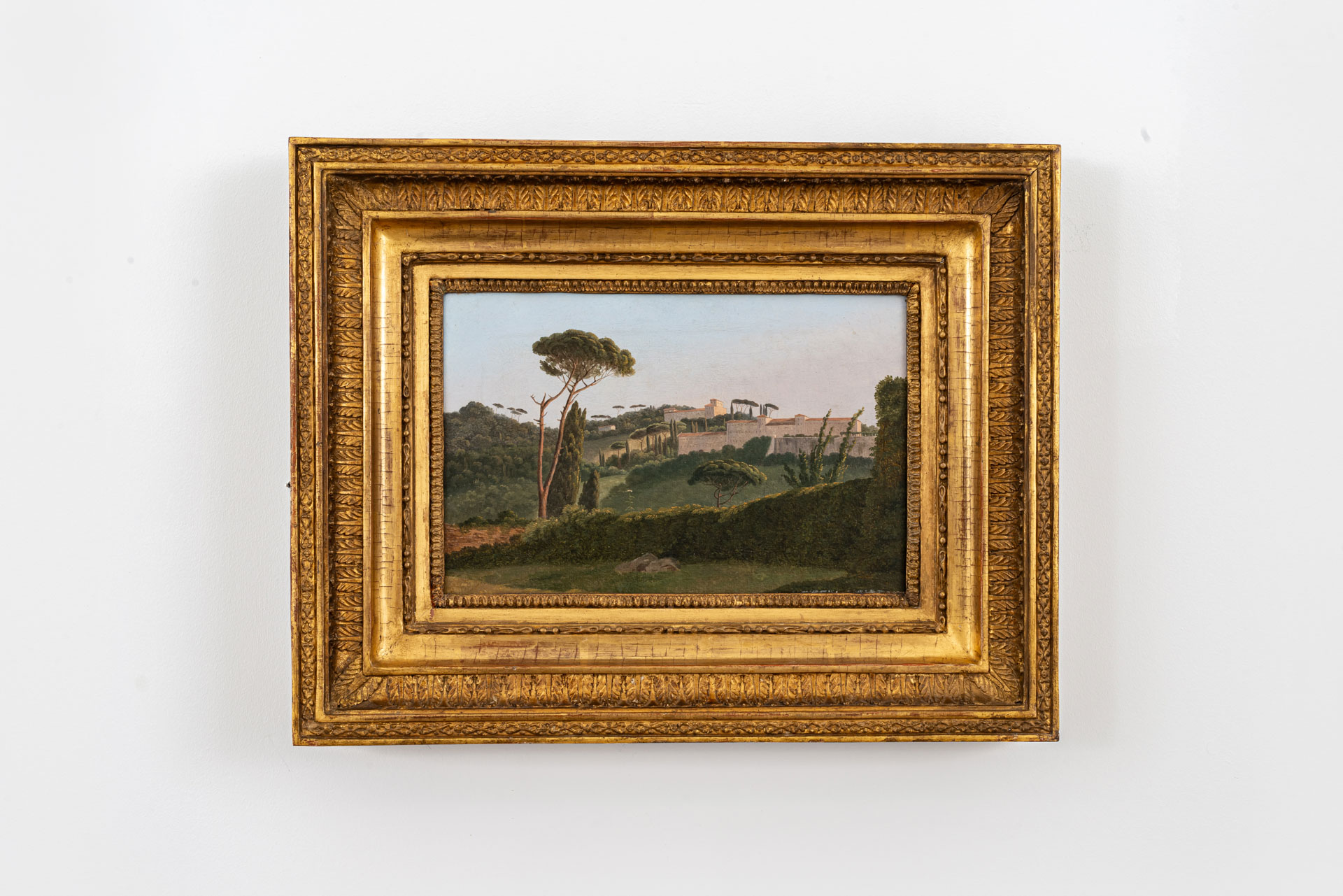
Pierre-Athanase Chauvin, ‘Rome, View of the Villa Borghese behind the Villa Medicis’, 19th Century, 20,4 x 31 cm. Cirrus: On Landscape, November, 2024. NISO, London. Photography: Studio Adamson
NISO Founded in 2021, NISO is committed to supporting the next generation of talents as well as rediscovering the legacy of XXth Century artists whose remarkable contributions to Art History have gone unnoticed in recent times. Located in Central London, the gallery provides a dynamic platform to present solo exhibitions and intergenerational dialogues in collaboration with artists, estates, and representing galleries.
